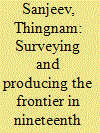| Srl | Item |
| 1 |
ID:
084987


|
|
|
|
|
| Publication |
2008.
|
| Summary/Abstract |
In 1945 Stephen B Jones, an American political geographer, published Boundary-Making: A Handbook for Statesmen, Treaty Editors and Boundary Commissioners in which he set out the practicalities of boundary delimitation, demarcation and maintenance. The significance of this volume to boundary scholars and practitioners cannot be overstated. Jones's book, outlining guidelines for good practice in boundary-making, continues to be consulted as a unique work of its kind. However, now over sixty years since publication, its age is starting to tell. The recent decision of the Eritrea-Ethiopia Boundary Commission (EEBC) reveals how some of the core concepts of Boundary-Making are being re-interpreted and some of the practices espoused by Jones may be in need of updating to encompass the changes in boundary-making during the last half century. Framing the discourse around the EEBC's notion of boundary 'demarcation', we examine the context in which Jones wrote his book, consider why it has become such an important work, and suggest how it can continue to be relevant for twenty-first-century boundary practitioners.
|
|
|
|
|
|
|
|
|
|
|
|
|
|
|
|
| 2 |
ID:
182599


|
|
|
|
|
| Summary/Abstract |
The controversy surrounding the Simla Conference of 1913–1914 and the legality of the McMahon line, which was produced by the Conference, has been at the centre of the boundary dispute between India and China. Amidst the diverging opinions amongst scholars and political commentators, the main issue rest on the unresolved question of Tibet’s political status. Was Lhasa authorised to sign treaties for Tibet? Was China the sovereign over Tibet? The answers to such questions are murky and complicated, made more so by the politics and conflicts in the post colonial period. This study attempts to highlight the complicated nature of political authority in Tibet through a study of British policy in Tibet towards the end of 19th and early 20th centuries. The signing of the 1890 Convention with China and the 1904 Convention with Tibet represents two extremes in British foreign policy which attest to the confounding situation presented before the British and the diverging opinions within the British official circles. The period between these two conventions provides a glimpse of the historical background in which the relations between British India, China and Tibet developed subsequently.
|
|
|
|
|
|
|
|
|
|
|
|
|
|
|
|
| 3 |
ID:
174798


|
|
|
|
|
| Summary/Abstract |
The second half of the nineteenth century was a turning point in the history of modern Manipur when it collaborated with the British in the first Anglo-Burmese War of 1824. With the conclusion of the treaty of Yandaboo 1826, Manipur was transformed into a frontier zone. In this backdrop, the paper explores the pre-colonial notion of territory and how it competed with the European notions of space. Boundaries were fluid, and land was perceived more in terms of people and social relations. The paper also highlights the impact of state formation and territorialisation on identity formation by referring to the changes in the management of the hills and the valley after the 1891 Anglo-Manipuri War. Demarcation of land and boundaries submitted to the logic of rule and control which resulted in the classification of land and people into far more rigid categories like the separate management of the hills and the valley.
|
|
|
|
|
|
|
|
|
|
|
|
|
|
|
|
| 4 |
ID:
178754


|
|
|
|
|
| Summary/Abstract |
The article examines temporary extramarital cohabitation arrangements between low-wage Chinese female migrants and their male counterparts in Singapore, a phenomenon which is widely referred to by the migrants as becoming a “temporary couple” or “teaming up to have a life.” In the simulated households, the men usually shoulder most of the daily expenses for both members, while the women are expected to take care of the men’s intimate needs and most of the housework. The vast majority of the women involved in such arrangements are married and migrated for work on their own. This article, based on ethnographic fieldwork conducted between 2016 and 2019, explores how these women perform and understand such temporary intimacies. I first demonstrate that the women enter the relationships as a reaction to the institutional setup that places them in a suspended status, in which they are treated as nothing more than temporary labourers. I then illustrate how the women put the relationship in a state of suspension: they instrumentalize it as a means to maximize savings, and mark it out as a short-term exception that will end abruptly once they leave Singapore. The structurally imposed and self-inflicted conditions of suspension limit the women’s agency to an ambiguous private domain that is away from both work and home. Drawing on my long-term ethnographic fieldwork, this article deploys the notion of suspension as a guiding concept to unravel the tensions and moral anxieties that the women experience with their temporary intimacies.
|
|
|
|
|
|
|
|
|
|
|
|
|
|
|
|